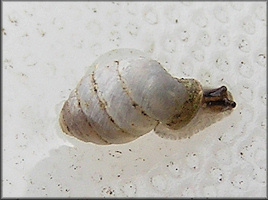 Reproduction
Reproduction
Like most other land snails, G. Armifera are functional
hermaphrodites, with each individual having two sets of sex
organs; tests, sperm, and penis; ovaries eggs, and oviduct and a
pouch or receptacle to receive the sperm of another individual.
In rare cases, self-fertilization is possible but normally
mating is between two individuals of the same species.
Egg-laying follows in various locations including under logs and
deep moist leaf litter.(Discover, 2011)
G. Armifera winters as eggs and quickly develops towards
maturity in the spring in the spring (Gugler,
1963). Their relatively large eggs (1.0 to 1.2mm in
diameter) are typically deposited at night. A snail that is
about to deposit an egg retracts inside its shell as the egg is
deposited into the body whorl. The egg is then pushed through
the aperture as the snail emerges from its shell. These eggs are
typically found covered in fecal material in groups of three to
six, lying on the surface on the soil.(Gugler,
1963)
A study done on specimens of G. Armifera collected in Nebraska
showed a different reproductive cycle. In hibernating adults
collected in winter and early spring, a delicate epiphragm (see
Adaptation) covered the aperture.
In most specimens, there was a second epiphragm at the level of
the teeth, and a hard epiphragm at a point in the body whorl
opposite the aperture. When brought into the laboratory such
specimens, even those chipped from solidly frozen soil, became
active within one to three days. Within eight to 15 days egg
deposition began normally (Gugler, 1963).
Instead of being covered with a hard outer coating like many
other eggs, G. Armifera eggs have a gelatinous covering. When
this coating is pierced, the egg immediately shrivels and loses
its fluid, but within 24 hours the egg is back to normal. Also,
when the egg is placed in an environment lacking water it
shrivels and shrinks. However, when placed in water the egg
returns to its normal spherical shape. In both of these cases
the egg continues to develop normally(Gugler,
1963).